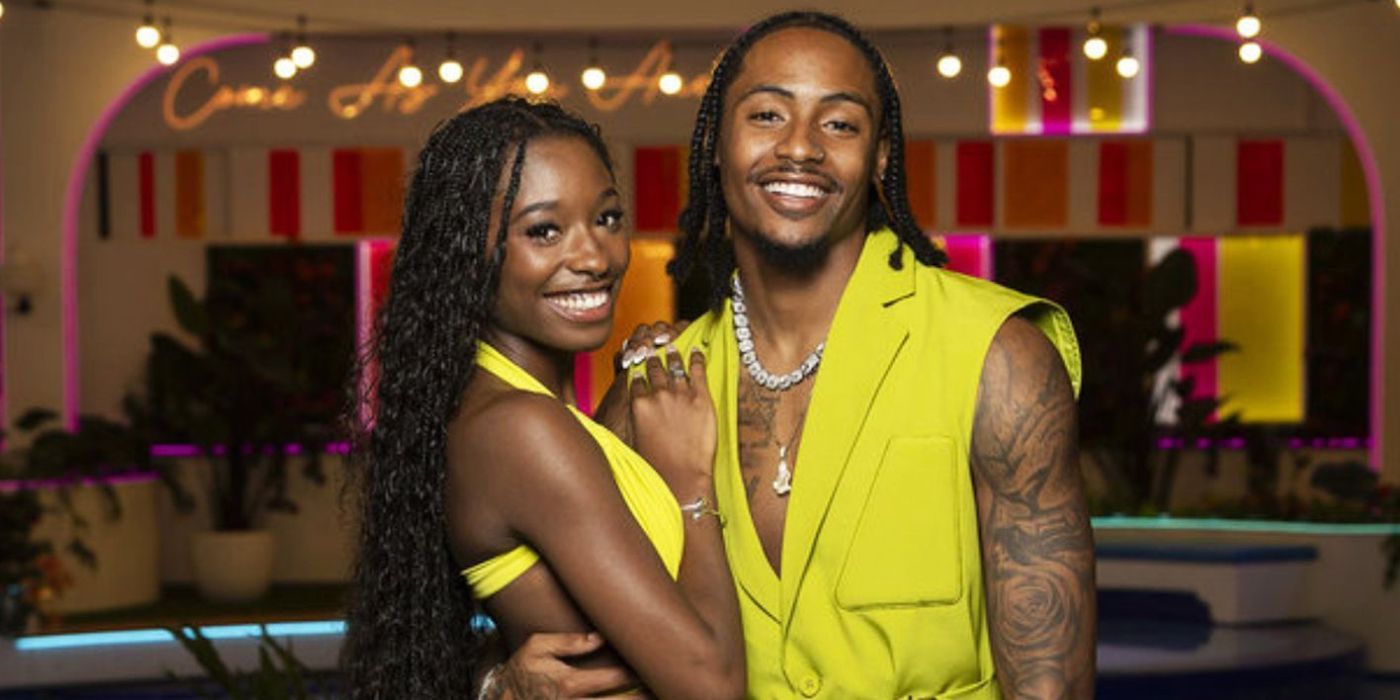The Big Picture
-
Love Island
captures audiences with its dramatic scenarios and engaging challenges, despite flaws in body representation and monotonous scenes. - The series appeals to fans of young adult romance, offering daily updates that immerse viewers in the drama of the relationships.
- Despite its superficiality,
Love Island
‘s addictive nature keeps viewers emotionally invested in the couples and their journeys.
Whether viewers first got hooked on the original Love Island: UK, or have joined the fan base more recently through the wildly popular Season 6 of the spin-off Love Island: USA, the franchise’s audience has skyrocketed since it first aired in 2015. For all its popularity, the series is not without its flaws. Detractors rightly point out that the series does not have a positive reputation for representing body types other than abs and more abs, and upholds unrealistic beauty standards. And though the producers work overtime to manufacture dramatic scenarios and editors work hard to cut together the juiciest scenes, the daily check-ins with the couples chatting can tend toward the monotonous.
Despite its flaws, Love Island has always had that lightning in a bottle magic that captures its almost obsessive audience’s attention. It’s the kind of series that used to be known as “water cooler TV,” the kind that everybody was talking about at the office the day after it aired. Except with Love Island, instead of having to wait a week between episodes, viewers get the bonus of tuning in daily. Now with the plethora of streaming platforms launching an ever-growing list of scripted and unscripted shows, it is a rare occurrence that a series can unite such a growing audience season after season, spin-off after spin-off.
If the popularity of YA fiction franchises like The Hunger Games, Twilight, and The Maze Runner have taught us anything, it is that people are low-key obsessed with young adults falling in love. It is endlessly intriguing to observe how the Islanders handle their romantic escapades and challenges. And with daily updates, it’s impossible not to get fully invested in the drama.
‘Love Island’ Certainly Has Its Problems
Any fan of the show must admit to its occasional flaws. Even at their best, the daily episodes can become mind-numbing with their lack of action and endless poolside small talk. The “Unseen Bits” episodes that air over the weekend are a bit of a snooze as well. The show is crammed full of manufactured, highly-edited content, where a dramatic soundtrack often highlights the absence of any real action. With that said, Love Island: USA Season 6 was a masterclass in how to pair poignant pop-songs with thematically similar scenes of reality TV love and heartbreak.
One glaring flaw is the lack of range in body types that is featured in the series. The contestants often fit a certain Ken and Barbie body type, with little to no variation. Each version of the show has repeatedly failed to deliver anything close to a realistic beauty standard, which leaves many viewers feeling alienated. While it is refreshing to see the ladies in their natural beauty when they wake up and go about their morning, many of the scenes feature them in full-face make-up, even while lounging poolside in string bikinis, or working out in Lululemon bra and short sets, or slipping down a bubble-filled slide during a Love Island challenge.
In some way, the unrealistic beauty standards the contestants uphold adds to the entertainment value. There is something fictitious in the couples’ “perfection,” which invites an immersion into a world where bizarre foam challenges and an endless dissection of dry conversations suddenly make sense. Love Island is now what Jane Austen was to her audience of readers obsessed with romance and Georgian-era manners; an excuse to detach from the harsh realities of daily life, and participate in a world where romance, love, and especially, manners, are a top priority. Watching the ladies dress down the lads once they return from Casa Amor is certainly proof that the series is at least partially an education on proper dating etiquette in modern life.
Love Island can at times be a goldfish-bowl study of constructed gender roles and social interaction. The girls all want a tall, muscular guy with “good chat.” The guys want a “pocket rocket” who looks fit in a bikini. Of course, many claim to not have a physical type, but it helps that everyone who comes into the villa inevitably fits societal beauty standards, and is content to conform to hetero-normative gender roles. This is similar to Love Is Blind, where the contestants all necessarily adhere to a certain standard of good looks, which helps when the doors slide back and the couples get to see each other for the first time.

Related
The 10 Best Couples on ‘Love Island USA,’ Ranked
We fell in love with these cute couples!
‘Love Island’ Is a Study in Human Nature
Love Island succeeds because it takes something we are all familiar with – dating, love, relationships – and puts it under the microscope in an environment specifically crafted to discourage the contestants from thinking of little else. It’s a social experiment disguised as a villa holiday in the sun. The men and women split into their gendered friendship groups to debrief morning and night over the day’s relationship progress. The women have their own make-up and dressing room where mutual reassurance and compliments are shared, whilst the men profess their self-assured banter in the main bedroom before the evening’s activities.
Territories are quickly drawn up, where it takes only a few days of conversation and bed sharing for couples who actually like each other to become co-dependent. Of course, they repeat that it’s only “early days,” but this premise goes out the window when a new “bombshell” tries chatting up an established islander. Attachment theories are performed onscreen as contestants profess their despair when a partner’s head “swivels” after only 24 hours. For the audience, there is the parasocial pleasure of watching the couples they think are suited get closer, while waiting for the suspected bad-faith players to be exposed.
So why do viewers enjoy this particular brand of reality television? If you look past what it means for society, and feminism, the predictability of this manufactured dating drama makes for a very enjoyable watch. Especially if you are lucky enough to have a spouse or friend-group who is watching along with you, egging on the Islanders with a true connection, and most importantly, tearing into those suspected of having insincere intentions. The “water cooler” element is actually the greatest part of the fun in watching, and with social media now at its apex, there is endless engagement online, gossiping with perfect strangers about what mad moves the Islanders have made. With a thorough understanding of its own niche, the show is the perfect example of a watchable guilty pleasure.
Daily Episodes Demand We Become Invested
The show is undoubtedly shallow, something Iain Stirling’s sarcastic voice-over is very aware of as he depreciates the ridiculous content as it unfolds. But, somewhat unbelievably, all this manufactured drama will eventually cause you to root for your favorite contestants. The first few weeks of the show always seem to drag, but this is because viewers have not had time yet to get properly invested in the emotional journeys of the couples. It helps that the show airs daily, as you really do get every detail of these budding onscreen romances. The all-day surveillance means that every high and low is captured – from the initial, seemingly insignificant, conversations to the first stolen kiss on the balcony.
Viewers quickly empathize with the onscreen plight of these couples, and continue to root for their favorites well after their season aired. Molly-Mae Hague and Tommy Fury, for instance, were such a perfect match that they have continued to capture the attention of the UK public, where millions have followed their journey from day one on the show, all the way through to their engagement and the birth of their first child, a daughter named Bambi. Maybe it’s nice to see a couple make it against all the odds – even if the difficult circumstances are initiated by the very show that brought them together. It seems that genuine feelings can and do grow from cheesy dates and silly challenges. And maybe this is the show’s winning secret – amid all the phoniness, there can be moments of authenticity and even love.
All of this means that the show is incredibly addictive. Once you break through your natural resistance to hours of idle vacation drivel, the series becomes truly enthralling. The show fuels its own narratives of love and loss, loyalty and betrayal, over several weeks of summer (and beyond, with the introduction of Love Island: All Stars and Love Island: Games spin-offs). Even when the pain of a break-up is achingly predictable, it is fascinating for the audience to revel in their ability to say they saw the signs. And although the day-to-day drama seems small, these are the grand themes it all adds up to. Ultimately, Love Island has its problems, and it certainly isn’t for everyone. But plow through the nonsense, and you too might just find that glimmer of emotional sincerity that keeps viewers emotionally invested in the series summer after summer, series after series.
Love Island is streaming on Peacock in the U.S.
Watch on Peacock


